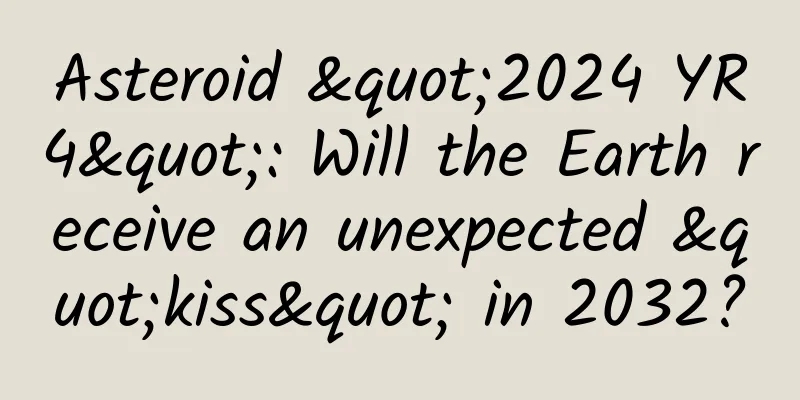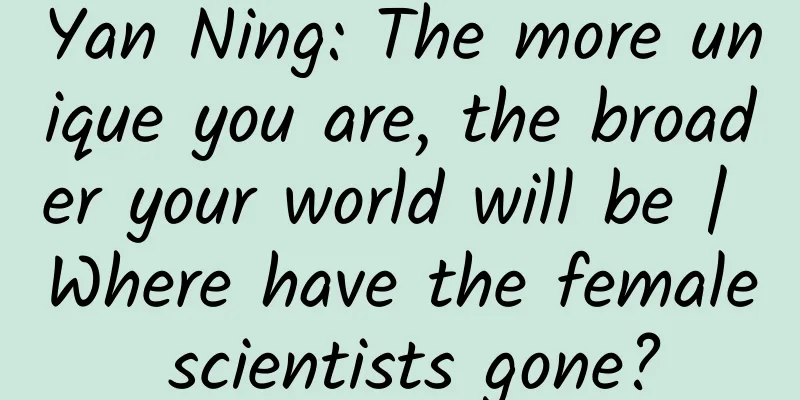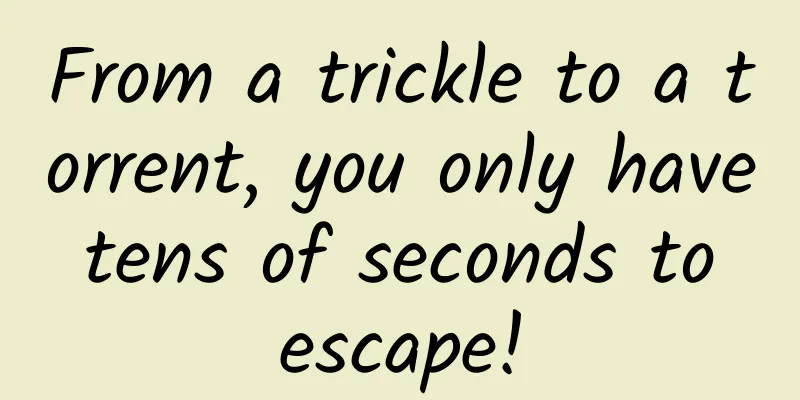Asteroid "2024 YR4": Will the Earth receive an unexpected "kiss" in 2032?

|
Author: Huang Xianghong Duan Yuechu In the vast and mysterious universe, the Earth is like a small boat, sailing alone surrounded by countless celestial bodies. Although humans have long entered the space age and their exploration of the universe is constantly deepening, potential threats from the depths of the universe are always around, and asteroid impacts are one of the most concerning. At the end of 2024, an asteroid named "2024 YR4" entered the field of vision of astronomers. Its appearance instantly attracted great attention from the world, because it is very likely to collide with the Earth in 2032, bringing great disaster to mankind. On December 27, 2024, the Asteroid Last Alert System (ATLAS) telescope in Chile keenly captured a fast-moving unidentified object, which was later named "2024 YR4". After careful calculation by astronomers, the volume of this asteroid is between 40 and 100 meters. It was closest to the Earth two days ago, when the distance from the Earth was about 800,000 kilometers, about twice the distance between the Moon and the Earth. John Toney, an astronomer at the University of Hawaii, described it vividly: "It zoomed right near the Earth." Although there are tens of thousands of asteroids of similar size or even larger in this area of the solar system, the appearance of "2024 YR4" has a unique significance and it requires special attention from humans. As follow-up observations were carried out, the situation became increasingly serious. On January 27, NASA's Sentry service upgraded its threat assessment for the asteroid. This service closely monitors potential asteroid impact risks by integrating observation data from telescopes around the world. Data shows that the probability of "2024 YR4" hitting the Earth on December 22, 2032 has risen from the initial estimate to 1.3%, which corresponds to the level 3 threat level in the Turin Scale. The Turin Scale is an indicator system that divides the degree of danger posed by asteroids to the Earth from level 1 to level 10. Level 3 means that the asteroid deserves the attention of astronomers, the public, and government officials. Just two days later, the European Space Agency (ESA) also released a similar assessment, further confirming the impact risk posed by "2024 YR4". As of the time of reporting, NASA's Sentinel service has increased the impact risk to 1.6%. Although the probability of "2024 YR4" hitting the Earth is still low, David Falconio, a scientist at the Center for Near-Earth Object Studies at NASA's Jet Propulsion Laboratory, said: "There is a 99% chance that this impact will be missed, which is what we expect to happen." However, it cannot be ignored that the risk it poses to the Earth is higher than any asteroid since 2000. Looking back at history, the Apophis asteroid discovered in December 2004 was briefly estimated to have a 2.7% chance of hitting the Earth in 2029, but with the improvement of subsequent observations, astronomers finally determined that it would safely miss the Earth. For "2024 YR4", astronomers originally expected a similar situation to occur, but the ongoing analysis has given the opposite result. Juan Luis Cano, planetary defense coordinator at the European Space Agency's Near-Earth Object Coordination Center, said helplessly: "The probability is increasing." This undoubtedly poses a difficult problem for mankind. If "2024 YR4" really hits the Earth, the consequences will be disastrous. Although it will not completely end life on Earth, the damage caused will be devastating. John Tony pointed out that an asteroid impact of this size is equivalent to a "10-megaton bomb", which is enough to cause widespread disasters in local areas. "Everything within three or four kilometers will be burned, and everything within about 10 kilometers will be smashed. This is not a nuclear explosion, but it is an extremely hot explosion, and there will be a huge fireball that starts to burn 15 kilometers away, something like that. If people don't avoid it in time, this will cause a lot of deaths." Melissa Brook, a planetary scientist at the University of Arizona, found through research that "2024 YR4" is a stony asteroid, not a metal-rich asteroid. This means that it is likely to explode under the pressure of the upper atmosphere instead of directly hitting the surface of the Earth. Its impact effect may be similar to the Tunguska event in Russia in 1908, when a suspected asteroid or comet exploded over Russia, and the powerful shock wave flattened 2,150 square kilometers of remote Siberian forests. Brooke said: "We think '2024 YR4' is about the same size as the object in the Tunguska event." Another example is the meteor explosion over the Russian city of Chelyabinsk in 2013, when a meteor estimated to be only 20 meters wide exploded, shattering windows and injuring hundreds of people. This shows that if '2024 YR4' hits the Earth, the consequences will be unimaginable. German amateur astronomer Daniel Bamberger has roughly determined the possible impact corridor of the asteroid through complex calculations. He said that although it is not yet possible to accurately determine where on Earth "2024 YR4" will hit, based on the expected impact date of December 22, 2032, it is possible to geographically restrict the areas on Earth that may be hit to a certain extent. The threatened area extends from the Pacific Ocean to northern South America, the Atlantic Ocean, sub-Saharan Africa, the Arabian Sea, and parts of South Asia. Bamberger admitted: "We know that one day we will find such a celestial body with a very high probability of impact." Richard Binzer, a planetary scientist at the Massachusetts Institute of Technology who created the Torino Scale in 1997, stressed that although the impact time of "2024 YR4" seems far away, its impact risk cannot be ignored. The probability of about 1% may seem insignificant, and the end of 2032 may seem out of reach, but the probability may change dramatically at any time. It will take years to develop and implement a plan to deflect the impactor or mitigate the impact. As astronomers continue to observe the asteroid and track its orbit more accurately, its Torino ranking may drop to Category 1 or even eventually Category 0. But if the results of orbital improvements show that "2024 YR4" is getting closer and closer to the Earth, its assessed hazard level may soar to Category 8, which is the highest level that an asteroid of this size can reach. "8 means some kind of collision," Binzer said seriously. Currently, astronomers are racing against time to find historical observation data, hoping to find clues to eliminate the risk of "2024 YR4" hitting the Earth. They speculate that there may be relevant observation records in telescope surveys when the asteroid passed by the Earth in 2016. Unfortunately, however, the archive search has been slow so far. Cano said helplessly: "We have been doing it for two weeks, but unfortunately, we have not succeeded." Time is of the essence in resolving this crisis. 2024 YR4 is currently moving away from Earth, and by April it will no longer be visible to telescopes. Outside of this short window, the next opportunity to observe the asteroid to assess its threat will not come until 2028, when it will pass near Earth again, the only chance before the worrying deadline of December 22, 2032. If the asteroid still poses an impact risk by then, humanity will have little time to develop an effective response. Therefore, it is particularly important to plan ahead and develop mitigation strategies in advance. "When it pops up in 2028, when the new observations come out, our mission will basically be ready," said John Toney, adding that if predictions show the asteroid will not hit Earth, "we can decide to let it go." Preparations for such a precautionary response could start as early as next week, when meetings of the United Nations' Space Mission Planning Advisory Group and the International Asteroid Warning Network are held among space agencies. "We will watch this object very carefully," Cano said. If the risk of an impact cannot be ruled out by April this year, the feasibility of a deflection mission in 2028 may need to be seriously discussed. "Eight years away from a (potential) impact is a very challenging scenario," Cano stressed. "It takes three to five years to design and build a mission. It will be very limited." Such a mission design might draw on NASA's dual asteroid redirection experiment, which successfully changed the orbit of an asteroid in September 2022. If a deflection mission is not feasible, then the next option might be to explore "ground evacuation measures" in the predicted impact area, a point made by David Falconio. However, if the threat from the asteroid does not dissipate as expected, it will take several years to have these serious discussions. At present, the most likely scenario is that more observations of "2024 YR4" will prove that it will not hit the Earth and will not pose any risk to the Earth. Moreover, there are numerous telescopes that can be used to observe it. Cano said that he has applied for observation time on NASA's James Webb Space Telescope, and Melissa Brook also said that she could use the Keck Observatory in Hawaii to look for "2024 YR4". Although the appearance of "2024 YR4" has brought great uncertainty and concern to mankind, astronomers' quick response to it has also brought us a glimmer of hope. In the face of natural disasters, especially extreme disasters like the universe throwing space rocks at the earth, humans used to feel powerless. However, today's global tracking and research of potentially threatening asteroids is making remarkable progress. Decades ago, it would have been a daunting task just to detect an object like "2024 YR4", not to mention accurately tracking its path and assessing its potential for destruction. Today, space scientists are very close to completing the census of large near-Earth objects and can more accurately determine their true danger. "All our efforts over the past 20 years have been completely dedicated to finding asteroids and assessing their likelihood of hitting the Earth, and that's why we are here," said Juan Luis Cano proudly. The appearance of "2024 YR4" has undoubtedly sounded the alarm for mankind, making us deeply aware of the fragility of the Earth in the universe and the potential threats. Although we cannot yet determine whether it will hit the Earth in 2032, through the joint efforts of scientists around the world and the continuous development of science and technology, we have reason to believe that mankind has the ability to meet this challenge and protect our home planet. In the days to come, we will continue to pay attention to the developments of "2024 YR4" and look forward to a reassuring result in the end. Reference: Newfound Asteroid May Hit Earth in 2032, Scientists Say|Scientific American is part |
<<: Yogurt, vinegar, honey water, do these hangover remedies really work? | Science Gallery
>>: Remind your family and friends! Don’t use this posture to browse your phone
Recommend
Sold for over 200,000 RMB, this may be the most expensive hair in the world
(Public Domain) Recently, a media article stated ...
Last time I released a version, I changed only one line of code!
Dynamically change application icons Product: Can...
Perfect Diary’s secret to live streaming on Tik Tok!
Tik Tok has always been an important platform for...
Boston Consulting Group: Carbon Emissions Survey Report 2024
Despite the worsening climate crisis and despite ...
Xiaomi Mi A1 releases kernel source code: turns into the little prince of flashing
[[218890]] In 2017, Xiaomi and Google collaborate...
"Data Mining Thinking and Practice" explores the hidden value of data and builds a high-paying knowledge framework
Training course content: This course starts from ...
China Passenger Car Association & Anluqin: The new four modernizations index of passenger cars in December 2021 is 69.4
The Passenger Car New Four Modernizations Index, ...
Psychological research: Don't spend all your time together, or the cost will be...
Leviathan Press: In the movie Little Children (20...
How can a newbie make money with Huajiao Live? How much can a newbie make in a day with Huajiao Live?
Five years ago, if you said that live streaming c...
There are many lunar exploration orbits, and the key is to choose wisely
Recently, NASA launched the first lunar explorati...
AutoNavi and DAMO Academy jointly launch in-car AR navigation, making driving easier
On October 17, AutoNavi Maps announced that it wo...
Do all airplanes look the same? Actually, they are very different.
Compared to the 1950s and 1960s, when there were ...
Apple iOS 15 officially released: new notification interface and FaceTime, big improvements to weather, photos, and wallet
June 8 news: Early this morning, Apple held the W...
Half of Chinese people are infected with Helicobacter pylori. Huaxi doctors: If you don't pay attention to this during the Chinese New Year, you are most likely to get
Happy New Year 🎉 Workers returning home The dinne...









